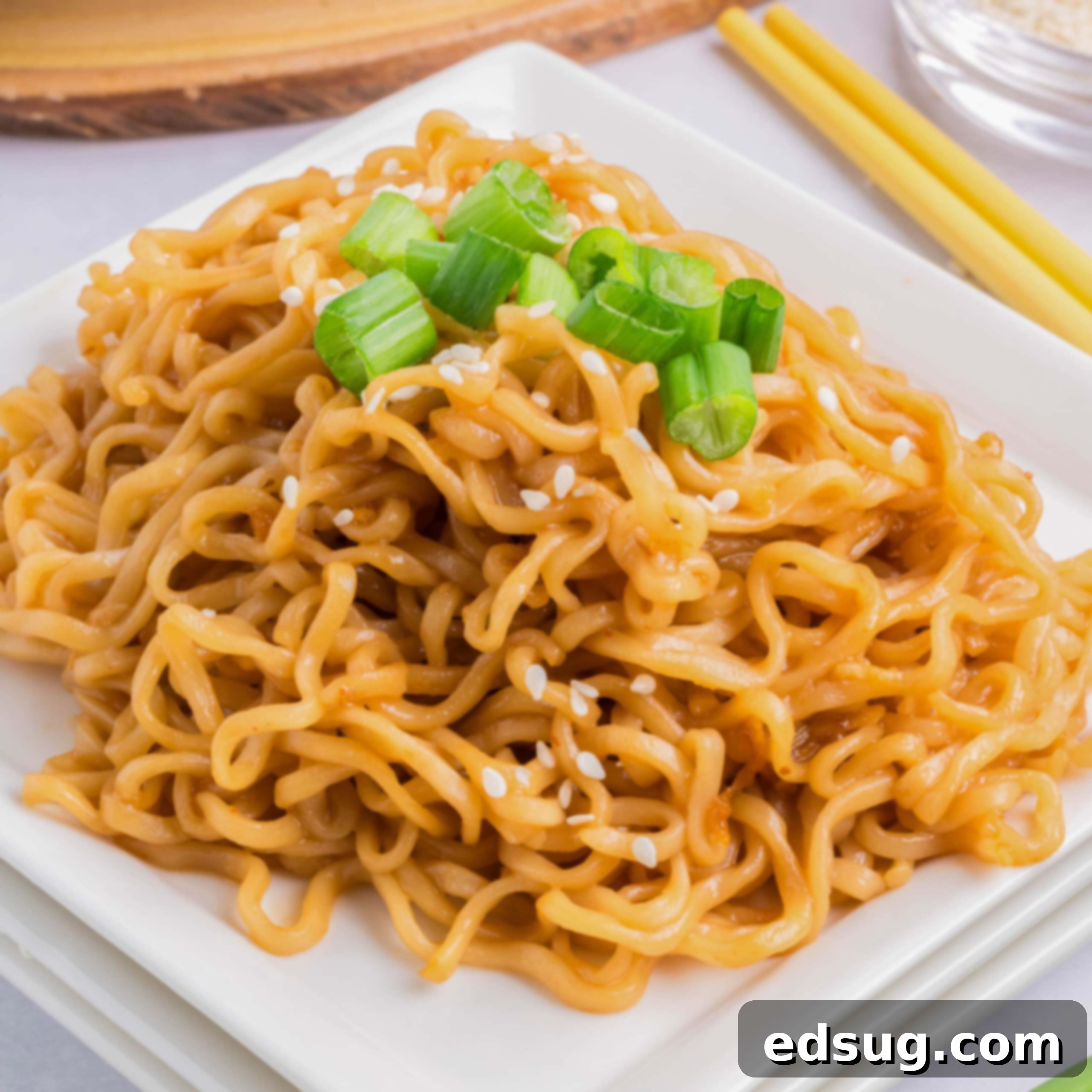Quick & Easy 15-Minute Sesame Noodles: Your Ultimate Weeknight Meal Solution
If you’re a lover of vibrant, Asian-inspired flavors and constantly find yourself short on time, these incredibly delicious Sesame Noodles are about to become your new weeknight hero. Bursting with savory, sweet, and subtly spicy notes, this dish is a flavor powerhouse that magically comes together in just 15 minutes. Forget complicated recipes or long ingredient lists; this is the perfect solution for those crazy busy evenings when you need a satisfying and impressive meal without the fuss.
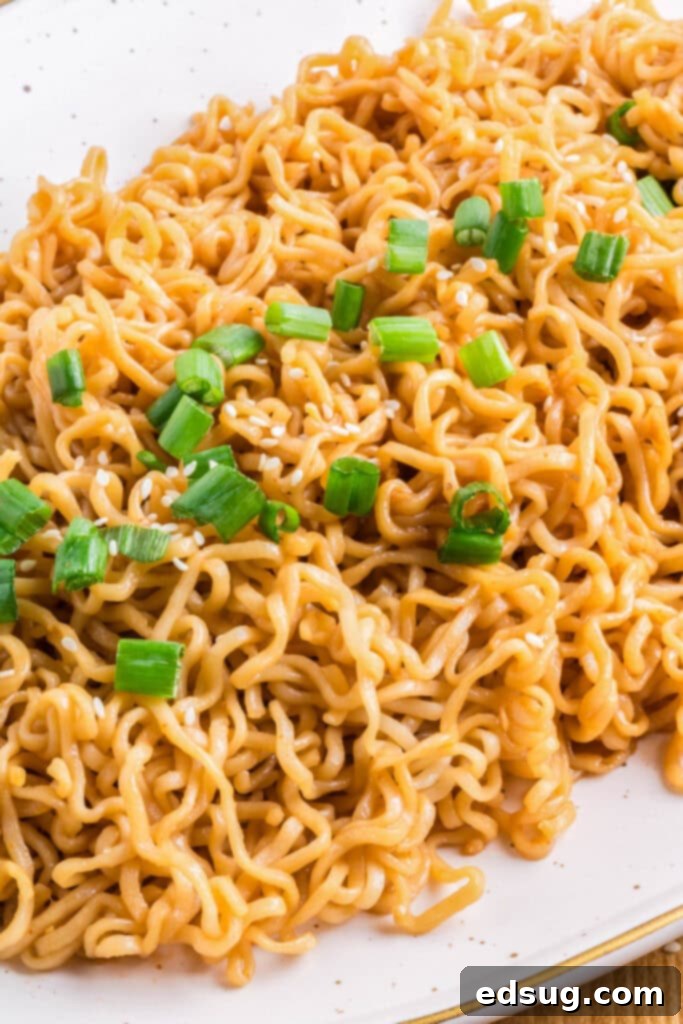
Life can be hectic, and sometimes, dinner plans simply fall through. You might be staring into your fridge with no inspiration, craving something satisfying but without the energy for an elaborate cooking session. That’s precisely when these Sesame Noodles shine. Requiring no prior thawing or extensive planning, they rely on simple pantry staples you likely already have on hand. It’s truly a dream come true for anyone seeking a fast, flavorful, and fuss-free dinner during the week.
Asian-inspired recipes are consistently among the most popular and beloved dishes, and for good reason! Their dynamic flavors and adaptability make them incredibly appealing. This particular sesame noodle recipe is a fantastic base that you can easily customize with your favorite proteins and a colorful array of vegetables, transforming it into a complete, wholesome, and incredibly satisfying meal tailored to your tastes.
Why You’ll Adore This Sesame Noodle Recipe
- Effortless Preparation – Forget about gourmet cooking techniques or obscure ingredients. This recipe calls for just a handful of everyday items that are readily available at any grocery store. You can easily stock up on them, ensuring that a delicious, homemade meal is always just moments away, even on your most challenging days.
- Blazingly Fast – We mean it: 15 minutes! From boiling the water to tossing the finished noodles, this entire dish is designed for speed. It’s perfect for last-minute meals, hurried lunches, or simply when you’re too hungry to wait. Spend less time in the kitchen and more time enjoying your meal and your evening.
- Incredibly Versatile – This recipe is a blank canvas for your culinary creativity. Want to boost the protein content? Add cooked chicken, shrimp, beef, pork, or even tofu. Have an abundance of vegetables in your fridge that need to be used up? Toss in bell peppers, broccoli florets, snap peas, shredded carrots, or mushrooms. This dish adapts beautifully to whatever you have on hand, allowing you to create a unique and satisfying meal every time.

Essential Ingredients for Perfect Sesame Noodles
For precise measurements and detailed steps, be sure to scroll to the bottom of the post for the FULL PRINTABLE recipe card.
- Ramen Noodles – The beauty of this recipe is its flexibility with ramen. Whether you opt for inexpensive instant ramen (just discard the seasoning packet!), a higher-quality dried ramen noodle from the Asian aisle, or even fresh ramen from a specialty store, they all work wonderfully. The key is to cook them al dente for the best texture.
- Reserved Pasta Water – This often-overlooked ingredient is crucial! A couple of tablespoons of the starchy cooking water will help emulsify your sauce, giving it a luxurious, smooth texture that clings perfectly to the noodles.
- Unsalted Butter – While not traditionally Asian, butter adds a rich, luscious depth to the sauce that complements the sesame oil beautifully, creating a well-rounded flavor profile.
- Sesame Oil – The star of the show, delivering that distinctive nutty, aromatic flavor essential to sesame noodles. Use toasted sesame oil for the most robust taste.
- Fresh Garlic, Minced – Fresh garlic is non-negotiable for its pungent aroma and flavor. Minced finely, it provides a powerful base for our sauce.
- Low Sodium Soy Sauce – Using low sodium allows you to control the saltiness of the dish more effectively. If using regular soy sauce, you might want to adjust other salty components or add less. Tamari is a great gluten-free alternative.
- Light Brown Sugar – This sweet component balances the savory soy sauce and spicy sriracha, adding a touch of caramel-like sweetness that rounds out the flavor.
- Sriracha – For that signature spicy kick! You can easily adjust the amount to suit your preference, from a mild hint of heat to a fiery experience. Chili garlic sauce is another excellent option if you prefer a more complex spicy note.
- Fresh Grated Ginger – Fresh ginger provides a vibrant, zesty warmth that elevates the sauce. While ginger in a tube can be a decent substitute, avoid ground ginger if possible, as its flavor profile is significantly different and less impactful in this type of sauce.
- Sliced Green Onions – A fresh, crisp garnish that adds a mild oniony bite and a beautiful pop of color, enhancing both the taste and presentation.
- Toasted Sesame Seeds – Essential for visual appeal, a delightful crunch, and an extra layer of nutty sesame flavor. Don’t skip these!
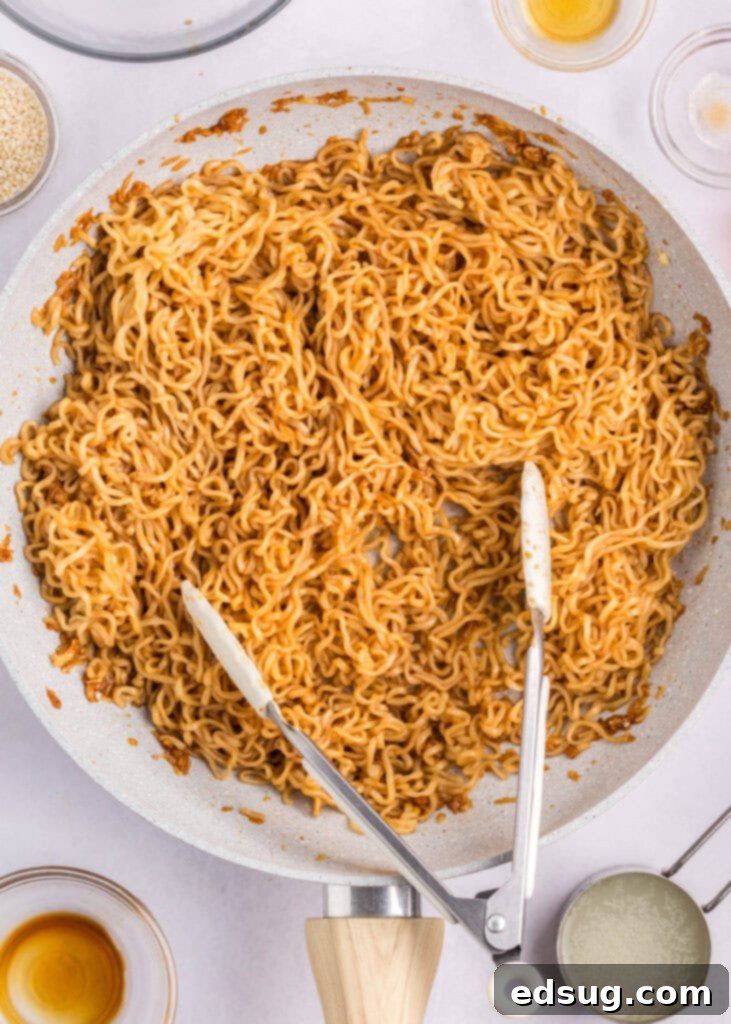
Simple Steps to Your 15-Minute Sesame Noodles
- Cook the Ramen Noodles. Begin by bringing a medium pot of water to a rolling boil. Add your chosen ramen noodles and cook them strictly according to the package directions until they are just al dente. This typically takes only 2-3 minutes for instant ramen. If you’re using instant ramen, remember to discard the seasoning packet – we’re making our own delicious sauce! Crucially, before draining the noodles, scoop out and save about 2 tablespoons of the starchy cooking water. This water is your secret weapon for a perfectly smooth sauce.
- Sauté the Garlic Aromatics. While the noodles are cooking, place a large skillet or wok over medium heat. Add the unsalted butter and sesame oil to the skillet. Once the butter has fully melted and the oil is shimmering, add the minced garlic. Sauté for approximately 1 to 2 minutes, stirring constantly, until the garlic becomes incredibly fragrant and lightly golden. Be careful not to burn the garlic, as this can make it bitter.
- Whisk Together the Irresistible Sauce. With the garlic perfectly fragrant, remove the skillet from the heat to prevent overcooking the aromatics. Add the low sodium soy sauce, light brown sugar, sriracha (adjusting to your preferred spice level), and fresh grated ginger directly into the skillet with the garlic. Stir vigorously with a whisk or spoon until all the ingredients are well combined and the brown sugar has completely dissolved, forming a cohesive sauce.
- Combine and Toss for Perfection. Now, it’s time to bring everything together! Add the cooked and drained ramen noodles directly into the skillet with your freshly made sauce. Use tongs to gently toss the noodles, ensuring every strand is thoroughly coated in the flavorful mixture. As you toss, gradually add the reserved pasta water, stirring it in until the sauce reaches your desired consistency – it should be thick enough to cling to the noodles but still a bit glossy.
- Garnish and Serve Immediately. Transfer your beautifully coated sesame noodles to serving bowls. Finish the dish by generously sprinkling sliced green onions and toasted sesame seeds over the top. Serve hot and enjoy the incredibly quick, flavorful, and satisfying meal you just created!
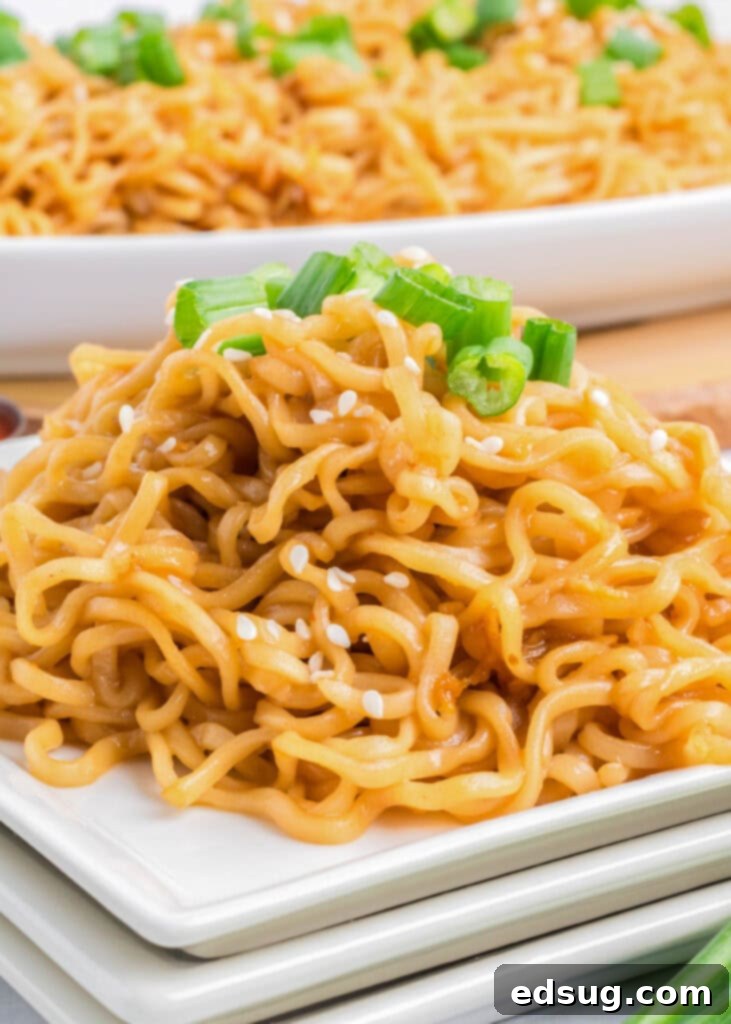
Expert Tips & Creative Variations for Your Sesame Noodles
- Exploring Ramen Noodle Options. While “instant” ramen is incredibly convenient, don’t limit yourself! You can find packages of ramen noodles without seasoning in the Asian section of most grocery stores, offering a slightly better quality. For an authentic experience, visit an Asian market for fresh or frozen ramen noodles, which boast a superior chewy texture. Regardless of your choice, the beauty of this recipe is its adaptability.
- Incorporate More Veggies for Flavor and Health. This is where you can truly make the dish your own! Consider adding finely sliced bell peppers (red, yellow, or orange), crisp broccoli florets, tender snap peas, sliced mushrooms, shredded carrots, or even a handful of spinach. For firmer vegetables like broccoli or carrots, you can stir-fry them briefly with the garlic for a few minutes before adding the sauce. Softer vegetables like spinach can be tossed in at the very end with the noodles, allowing them to wilt gently from the residual heat.
- Boost with Protein. Transform these noodles into a hearty main course by adding your favorite protein. Cooked chicken (shredded rotisserie chicken works wonders for speed!), pan-seared shrimp, thinly sliced pork, savory beef strips, or firm tofu cubes are all fantastic additions. Cook your protein of choice separately before you start the sauce, then add it to the skillet along with the noodles, tossing to combine. This ensures your protein is perfectly cooked and evenly coated.
- Adjust the Spice Level to Your Liking. If you’re a true spice enthusiast, feel free to increase the amount of sriracha. For an extra layer of heat and flavor, you could also stir in a dash of chili garlic sauce, a pinch of red pepper flakes, or a drizzle of chili oil at the end. If you prefer a milder dish, simply reduce the sriracha or omit it entirely.
- Experiment with Different Noodle Varieties. While ramen is traditional here, this versatile sauce pairs well with many types of noodles. Try it with linguine or spaghetti for an Italian-Asian fusion, chewy udon noodles, delicate rice noodles (ensure they’re cooked according to package directions and often benefit from a quick rinse after draining), or even soba noodles for an earthy flavor. Just ensure you adjust cooking times based on the noodle type.
- Gluten-Free Adaptation. To make this recipe gluten-free, the primary substitution needed is tamari instead of soy sauce. Additionally, be sure to use certified gluten-free ramen or rice noodles, as traditional ramen often contains wheat.
- Vegan-Friendly Options. For a fully vegan dish, simply replace the unsalted butter with a plant-based butter alternative or an additional tablespoon of sesame oil. Also, ensure your chosen ramen noodles are egg-free, as some varieties may contain egg.
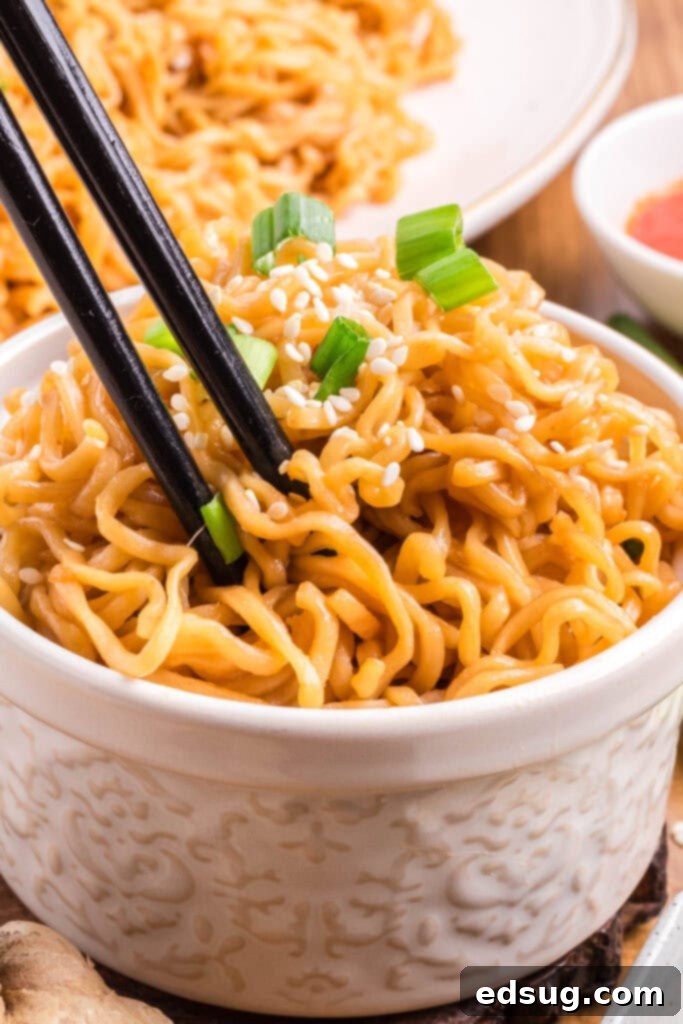
Complementary Dishes: What To Serve With Sesame Noodles
These Sesame Noodles are robust enough to stand alone as a flavorful main dish, especially when bulked up with protein and vegetables. However, they also make a fantastic side dish. If you’re looking to create a complete, restaurant-quality Asian-style meal right at home, here are some of our favorite pairings that will elevate your dining experience:
- Warming Soups – Start your meal with a comforting bowl of Egg Drop Soup, a classic and light choice; a hearty and savory Wonton Soup; or the bold, tangy, and spicy flavors of Hot & Sour Soup. These soups perfectly balance the richness of the noodles.
- Crispy Appetizers – Enhance your meal with some delightful crunch! Fresh and light Shrimp Summer Rolls offer a refreshing contrast, while savory and perfectly golden Air Fryer Egg Rolls are always a crowd-pleaser.
- Flavorful Proteins – Pair your noodles with other Asian-inspired protein mains. The sweet and savory notes of Korean Beef Kebabs, the succulent and sticky Char Siu Pork, or the zesty and spicy Kung Pao Chicken Meatballs would all create a wonderfully balanced and varied spread.
- Simple Vegetable Sides – For a lighter addition, consider serving steamed or stir-fried bok choy with a touch of garlic, blanched green beans, or a crisp cucumber salad dressed with rice vinegar and a sprinkle of sesame seeds.
Storage & Reheating Instructions
These Sesame Noodles are fantastic as leftovers and reheat beautifully, making them an excellent choice for meal prep. Store any cooled leftovers in an airtight container in the refrigerator for up to 3 days. To reheat, you can simply microwave them until warmed through, adding a splash of water or a tiny bit of sesame oil if the noodles seem a bit dry to help loosen them up and restore their glossy texture. Alternatively, gently reheat them in a skillet over medium-low heat, stirring occasionally, until hot.
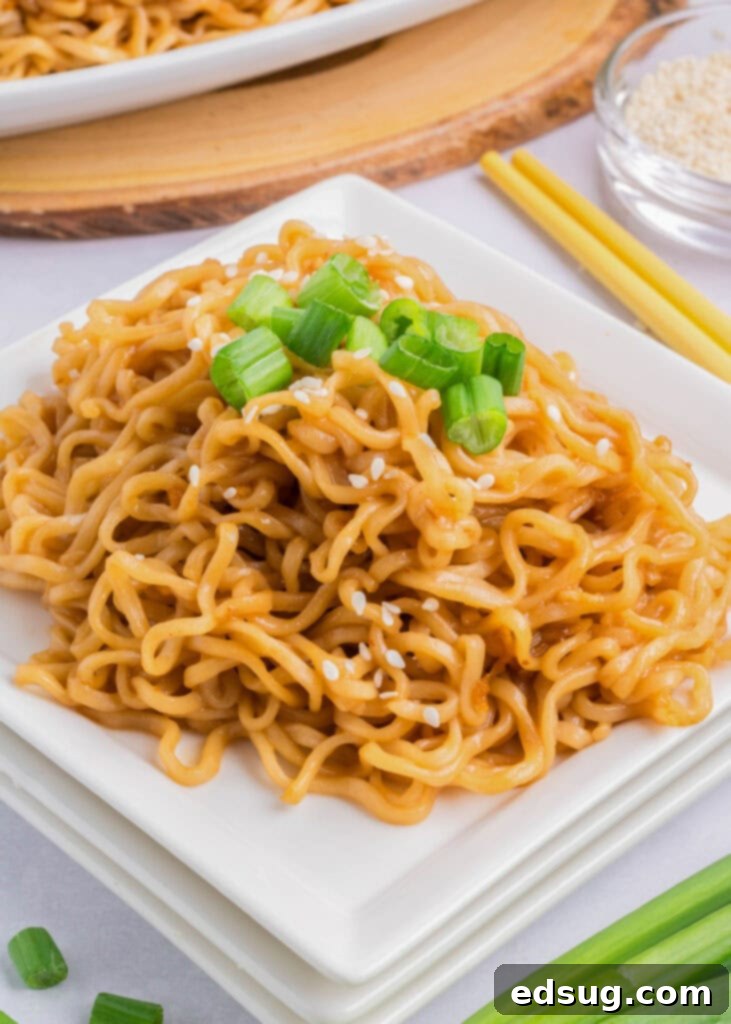
Frequently Asked Questions About Sesame Noodles
Can I make these sesame noodles gluten-free?
Absolutely! To make this recipe gluten-free, you will need to substitute regular soy sauce with tamari, which is a gluten-free alternative that tastes very similar. Additionally, ensure that the ramen noodles you choose are certified gluten-free, as most traditional ramen contains wheat. Rice noodles are another excellent naturally gluten-free option.
What if I don’t have sriracha? Are there other ways to add spice?
Yes, if sriracha isn’t available, you have several options! You can use chili garlic sauce for a similar heat with a bit more complexity, or a pinch of red pepper flakes for simple heat. For a different flavor profile, you could also experiment with a dash of gochujang (Korean chili paste) or a few drops of your favorite chili oil. Adjust the quantity to your preferred spice level.
Can I prepare the sauce in advance?
Yes, you can definitely prepare the sesame noodle sauce ahead of time! Whisk all the sauce ingredients (sesame oil, butter, minced garlic, soy sauce, brown sugar, sriracha, and ginger) together and store it in an airtight container in the refrigerator for up to 3-4 days. When ready to cook, simply heat the sauce in a skillet, cook your noodles, and toss everything together. This can shave even more time off your dinner prep!
How can I make this dish a complete meal?
These sesame noodles are incredibly versatile for making a complete meal. As mentioned in the variations, you can add cooked protein like chicken, shrimp, beef, or tofu. You can also load it up with various vegetables such as broccoli, bell peppers, carrots, or snap peas. Cooking the protein and firmer vegetables first, then adding the sauce and noodles, creates a balanced and satisfying one-pan meal.
More Easy Asian Recipes to Explore
If you loved the ease and flavor of these Sesame Noodles, you’re in for a treat! Our collection of Asian-inspired recipes offers a wide array of quick, delicious, and approachable dishes that bring authentic flavors to your home kitchen without requiring hours of effort. Dive into these other favorites:
- Mongolian Pork: Sweet, savory, and tender pork in a rich sauce.
- Orange Chicken: A homemade take on the classic takeout favorite, crispy and tangy.
- Spicy Chicken Stir Fry: Quick-cooking chicken and vibrant vegetables coated in a spicy sauce.
- Coconut Curry Shrimp: Succulent shrimp in a creamy, aromatic coconut curry.
- Teriyaki Chicken Noodle Bowls: Wholesome and customizable bowls packed with teriyaki flavor.
- Kung Pao Chicken: A spicy, sweet, and nutty stir-fry with tender chicken and peanuts.

Sesame Noodles
Pin Recipe
Rate Recipe
Print Recipe
Ingredients
- 6 oz ramen noodles
- 2 Tablespoons water from cooking ramen
- 1 Tablespoon unsalted butter
- 1 Tablespoon sesame oil
- 3 cloves garlic, minced
- 1/3 cup low sodium soy sauce
- 1 Tablespoon light brown sugar
- 1 1/2 teaspoon sriracha, more if you like it spicy
- 1 teaspoon fresh grated ginger
- 3 Tablespoons sliced green onions
- 1 teaspoon sesame seeds
Instructions
-
Bring a pot of water to boil and cook the noodles according to the package directions. If you are using instant ramen, be sure to discard the seasoning packet. Save 2 Tablespoons of the cooking water before you drain the noodles.6 oz ramen noodles, 2 Tablespoons water from cooking ramen
-
In a skillet add the butter and sesame oil over medium heat. Once the butter is melted add the garlic and cook for about 2 minutes, until you can start to smell it.1 Tablespoon unsalted butter, 1 Tablespoon sesame oil, 3 cloves garlic
-
Add the soy sauce, brown sugar, sriracha and ginger to the garlic and stir until it comes together and makes a sauce. Remove from the heat.1/3 cup low sodium soy sauce, 1 Tablespoon light brown sugar, 1 1/2 teaspoon sriracha, 1 teaspoon fresh grated ginger
-
Add the noodles to the pan and mix until everything is fully combined. Add the reserved water to get the mixture to come together and make a sauce.
-
Top with green onions and sesame seeds to serve.3 Tablespoons sliced green onions, 1 teaspoon sesame seeds
Nutrition
Nutrition information is automatically calculated, so should only be used as an approximation.
Additional Info
Like this recipe? Leave a comment below!
I created a fun group on Facebook, and I would love for you to join us! It’s a place where you can share YOUR favorite recipes, ask questions, and see what’s new at Dinners, Dishes and Desserts (so that you never miss a new recipe)!
Be sure to follow me on Instagram and tag #dinnersdishes so I can see all the wonderful DINNERS, DISHES, AND DESSERTS recipes YOU make!
Be sure to follow me on my social media, so you never miss a post!
Facebook | Twitter | Pinterest | Instagram
.
